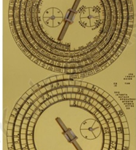By Marianna & Christiana Kriki
It was found by some sponge men on a shipwreck near the Greek island of Antikythera. After further research and based on the Greek inscriptions it carries, it was dated between 150 BC and 100 BC.
Usage
This mechanism is an ancient artifact that functioned as an analogue, mechanical computer and an astronomical observation instrument. It also presents similarities with a complex clock mechanism. Specifically it was used to accurately calculate the position of the Sun, the Moon, and possibly the planets Hermes, Venus, Mars, Jupiter and Saturn. It calculated the phases of the Moon, predicted both sun and moon eclipses, and also predicted the date of the ancient Stephanite and other PanHellenic games.
Its complexity is much greater than that of all the devices that man made over the next millennium.
Structure
It was made out of bronze and was assembled in a wooden box 32cmx16cmx10cm (about as much as a current Laptop!). It contained at least 35 cooperating gears rotating around 10 axes. The operation of the mechanism resulted in, at least, 5 dials, with one or more indicators for each.
Front view: It has two concentric circular scales.
- The outer scale has 365 subdivisions with the option of adding an extra day every four years and the names of the 12 months in Egyptian language with Greek characters.
- The internal scale has 360 subdivisions and the names of the 12 constellations.
Back view: It has two helical spirals.
- The upper helical spiral has 5 windings. Its total length was divided in 235 segments each corresponding to the 235 months (19 years) of the Methon period. In the empty space inside the spiral there is a smaller circular scale, divided in quadrants.
- The lower helical spiral has 4 windings. Its total length was divided in 223 sections each corresponding to the 223 months of the Saros period. In the months, where eclipses occur, someone can distinguish engraved symbols (H, S, EH, OH). In the empty space inside the spiral there is a smaller circular scale, divided in three sections.
Nowadays investigations about the mechanism are still underway. The mechanism is kept in the archaeological museum of Athens.
We still have a lot to discover about the Antikythera mechanism. Its significance as a scientific discovery is extremely great for the scientific community and proves once more time the ingenuity and resourcefulness of our ancestors.





